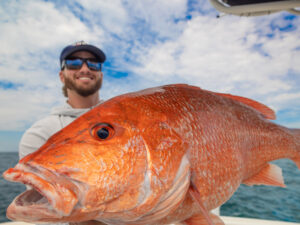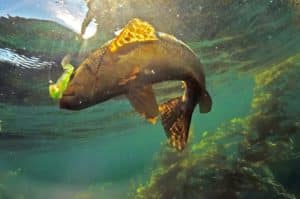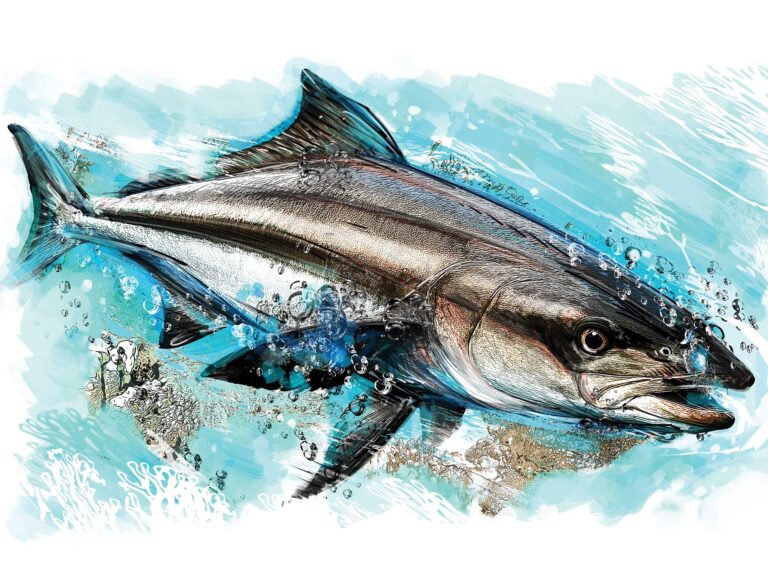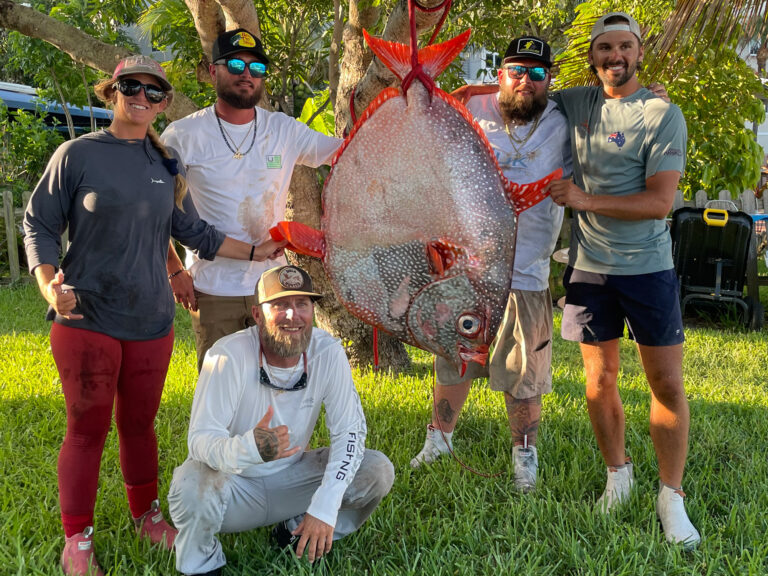Tarheel Streamers
QUESTION:
My granddaughter saw these fish off my dock. No one seems to know what they are. Do you have any idea?
Chuck Hindermyer
Little River, South Carolina

ANSWER:
What magnificent little fish! Juvenile stages of several western central Atlantic jacks (family Carangidae) bear elongated dorsal-fin spines, including the Caribbean or full moonfish, Selene brownii; the Atlantic moonfish, S. setapinnis; and the lookdown, S. vomer. However, the fish in your photo have both dorsal- and anal-fin spines that are extremely elongated, which identifies them as juvenile African pompano, Alectis ciliaris. African pompano range worldwide in tropical, subtropical and warm temperate waters. While the young are pelagic, adults are usually associated with reefs at depths to 300 feet, and seem to be fond of artificial reefs and especially wrecks. The largest on record measured nearly 5 feet long (the all-tackle record weighed 50½ pounds). While often released by conservation-minded anglers, African pompano are excellent table fare, especially at smaller sizes.
—Ray Waldner
Banded Mississippi Native
QUESTION:
My partner, Capt. Kenny, was pulling a small bait trawl near the ship channel north of Cat Island off the Mississippi coast. Among a pile of shrimp, croakers and normal bycatch was this weird-looking fella. It looks like the silver perch that seem to be everywhere down here, but we’ve never seen the coloring on this one. The face seems to be somewhat more rounded too. Could this possibly be some sort of hybrid or a foreign or undiscovered species? We let the little guy go but would really like to know what it is. Thanks!
Sonny Schindler
Shore Thing Charters
Bay Saint Louis, Mississippi

ANSWER: Sonny, you have a pretty good eye. That well-marked little fish is a banded drum, Larimus fasciatus, closely related to the silver perch. These two species, along with several others found in our estuaries, are small members of Sciaenidae, the drums and croakers. But since they rarely take a hook, we see them only as you did, captured in a bait trawl. We are all familiar with their heftier cousins, spotted sea (speckled) trout, red drum and black drum. The drum family is abundant around the world, and often the dominant family around tropical and subtropical estuaries. One peculiar feature of the drums is that the lateral line extends all the way to the tip of the tail fin. Your banded drum tops off at about 8 or 9 inches, and is found along the U.S. south Atlantic and Gulf coasts south to Vera Cruz, Mexico, though are rare in South Florida. While we consider banded drum as estuarine residents, they do venture offshore and may be found several hundred feet deep.
—Bob Shipp
High-Seas Drifter
QUESTION:
I found this little guy on the surface of the Pacific off the Golfo Dulce in southern Costa Rica. Some folks who have seen the photo say it’s a kind of nautilus, but it doesn’t look like photos of nautiluses I’ve seen online. It looks more like a regular squid to me, but in a shell. At one point, it came completely out. The shell was full of eggs. Any ideas?
Cory Craig
Costa Rica

ANSWER:
That glorious creature is an argonaut (also called a paper nautilus), genus Argonauta. Basically, argonauts are pelagic octopuses that make shells filled with air. Argonauts live throughout the world in the tropics and subtropics, at varying depths in the water column. Like other octopuses, argonauts have eight tentacles and use these to grab prey, in this case jellyfish, crustaceans and other open-water creatures. And, again, like their seafloor-dwelling relatives, argonauts can change their colors, squirt ink and produce a venom emitted through their beaks. Natural predators include open-ocean pelagics: billfishes, mahi and tunas. “Argonaut” refers to the sailors of the ship Argo, from Greek mythology, and “nautilus” means “sailor” in Greek.
—Milton Love
Gulf of Siam Stumper
QUESTION:
I caught this fish, measuring not quite 6 inches, close to the Cambodian territorial waters in the Gulf of Siam. It took a tiny piece of squid on the bottom. What can you tell me about it?
Francois Helias
anglingthailand.com
Bangkok, Thailand

ANSWER:
That is a cute little yellowbar sandperch (Parapercis xanthozona), also known as a peppered grubfish or java sandperch. It occurs throughout Southeast Asia to New Caledonia and the Great Barrier Reef. Sandperches (family Pinguipedidae) are interesting little bottom dwellers that are known by a variety of names, including grubfishes, weevers or sandsmelts. They are so named for their tendency to sit on the bottom in sandy patches between coral outcrops or on rubble patches in coral reefs and lagoons at depths of 20 to 60 feet. They zip around to feed on invertebrates (shrimps, crabs) and small fishes. There are more than 75 species of Parapercis, with the yellowbar sandperch distinguished by its distinctive color with the prominent white midlateral stripe extending through the tail, an orange-yellow bar at the base of the pectoral fins, and nine to 10 brown vertical bars below the lateral line. The yellowbar sandperch reaches only around 9 inches. Several narrow diagonal lines along the sides of the cheek identify this fish as a male. Females, on the other hand, have a few small brown spots in the same area, but the color can vary; indeed, some species of sandperches mature first as females before changing sex to males later in life (called protogynus hermaphrodism).
—Ben Diggles
Strange Slender Southerner
QUESTION:
This photo is from my distributor in Chile. He wrote, “This unusual visitor popped up in the fjords of central/southern Chile this fall.” Any ideas what it might be? I have never seen such an elongated tuna before.
Jeff Pierce
Scientific Anglers
Midland, Michigan

ANSWER:
Jeff, your observation of “an elongated tuna” is spot on. Your distributor caught a slender tuna, Allothunnus fallai. I asked Dr. Bruce Collette, the world’s expert on scombrid fishes (tunas, mackerels, bonitos and related species) to confirm my ID, and he replied: “I hate to ID from photos, but the slenderness of the tuna and its locality lead me to suggest Allothunnus. Sure would be nice to have a gill-raker count!” Bruce would like to know the number of gill rakers because slender tuna have more gill rakers than any other scombrid, typically 60 to 70. Slender tuna occur throughout the Southern Ocean at latitudes between 20° and 60°, although one was captured in Los Angeles Harbor and another in the North Pacific at a latitude of 49°N. In their normal range, slender tuna feed primarily on krill but also take small fish and squid. The IGFA all-tackle record weighed 26 pounds, 1 ounce, caught off New Zealand in 2001.
—John Graves
Read Next: Weirdest Fish Caught on Hook and Line
Sport Fishing‘s Prestigious International Panel of Experts
Northeast
Mike Fahay, Sandy Hook Marine Lab, New Jersey
Southeast
Ray Waldner, Ph.D., Palm Beach Atlantic University, Florida
Gulf of Mexico
Bob Shipp, Ph.D., University of South Alabama
West Coast
Milton Love, Ph.D., UCSB, California
Far Pacific
Ben Diggles, Ph.D., Queensland, Australia
Bluewater Pelagics
John Graves, Ph.D., Virginia Institute of Marine Science

CHALLENGE OUR EXPERTS (And Win Up to 10,800 Yards of Line!)
Send in your question and any relevant photos of your mysterious catch or observation for our experts’ ID and feedback. If we publish your question and you have a shipping address within the United States or Canada, you’ll win a 3‑pound spool of Berkley Pro Spec ocean-blue or fluorescent-yellow monofilament (1,000 to 10,800 yards, depending on line strength) or a 1,500‑yard spool of Spiderwire Stealth braid up to 100‑pound‑test! Send questions and images via email to fishfacts@sportfishing.com (include your hometown) or via post to Sport Fishing Fish Facts, 460 N. Orlando Ave., Suite 200, Winter Park, FL 32789.








